Grevillea victoriae
Grevillea victoriae, also known as royal grevillea or mountain grevillea,[2] is a species of flowering plant in the family Proteaceae and is endemic to mountainous regions of south-eastern continental Australia. It is an erect to spreading shrub with elliptic to lance-shaped leaves, and pendulous clusters of red to orange flowers.
| Royal grevillea | |
|---|---|
 | |
| Grevillea victoriae subsp. victoriae Mount Buffalo National Park, Victoria | |
| Scientific classification | |
| Kingdom: | Plantae |
| Clade: | Tracheophytes |
| Clade: | Angiosperms |
| Clade: | Eudicots |
| Order: | Proteales |
| Family: | Proteaceae |
| Genus: | Grevillea |
| Species: | G. victoriae |
| Binomial name | |
| Grevillea victoriae | |
| Subspecies | |
| |
| Synonyms[1] | |
| |
Description
Grevillea victoriae is an erect to spreading shrub that grows to a height of 0.2–4 m (7.9 in – 13 ft 1.5 in) and has more or less silky-hairy branchlets. Its leaves are elliptic or narrowly elliptic to lance-shaped, sometimes egg-shaped, 60–120 mm (2.4–4.7 in) long and 10–35 mm (0.39–1.38 in) wide. The upper surface of the leaves is more or less glabrous and the lower surface is densely silky- or woolly-hairy. The flowes are red to orange and arranged on the ends of the branches or in leaf axils in pendant, conical to loose, sometimes branched clusters on a rachis 20–90 mm (0.79–3.54 in) long, the pistil 17–26 mm (0.67–1.02 in) long. Flowering may occur in any month, but mainly from August to January in the absence of snow. The fruit is a glabrous follicle 17–20 mm (0.67–0.79 in) long.[2][3][4][5]
Taxonomy
The species was first formally described by Victorian Government Botanist Ferdinand von Mueller, his description published in his book, Definitions of rare or hitherto undescribed Australian plants in 1855.[6][7] Mueller discovered the species when he climbed to the plateau of Mount Buffalo in 1853.[8] He described it as "a truly majestic plant, when, by descending into the vallies it assumes a height of 12 feet or more."[9] The specific epithet victoriae was named for Queen Victoria.[5]
Three subspecies of G. victoriae are accepted by the Australian Plant Census and Plants of the World Online:
- Grevillea victoriae subsp. brindabella Stajsic[10][11] has leaves mostly 40–60 mm (1.6–2.4 in) long and 12–18 mm (0.47–0.71 in) wide with a dense layer of "tidy" silky hairs on the lower leaf surface concealing the underlying epidermis, and 38 to 50 flowers in each cluster;[12]
- Grevillea victoriae subsp. nivalis Stajsic & Molyneux[13][14] has leaves mostly 35–100 mm (1.4–3.9 in) long and 15–37 mm (0.59–1.46 in) wide with a dense layer of "messy" silky or woolly hairs on the lower leaf surface concealing the underlying epidermis, and 24 to 46 flowers in each cluster;[12][15][16]
- Grevillea victoriae F.Muell. subsp. victoriae[17][18] has leaves mostly 40–120 mm (1.6–4.7 in) long and 10–25 mm (0.39–0.98 in) wide with a dense layer of "tidy" silky hairs on the lower leaf surface concealing the underlying epidermis, and 22 to 48 flowers in each cluster.[12][19][20]
Grevillea victoriae complex
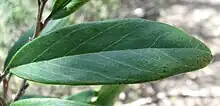

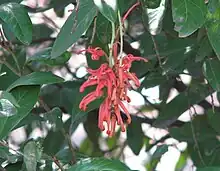

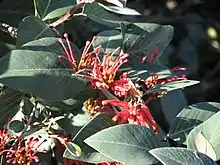
In 1993 Don McGillivray published an outline of 11 races of Grevillea victoriae as well as an associated description of unassigned specimens prompting fellow botanists to take a closer look at the Grevillea victoriae complex. The following year, Grevillea hockingsii from Queensland and G. mollis from New South Wales were segregated from the Grevillea victoriae complex by Peter Olde and Bill Molyneux. Bob Makinson segregated two further species, G. oxyantha and G. rhyolitica, in 1997.[21] Grevillea epicroca, G. irassa and G. monscalana were segregated and G. miqueliana was reinstated as a separate species in the Flora of Australia in 2000. In this publication, Makinson defined a Victoriae Subgroup within the genus Grevillea as follows:[22][23]
| Flora of Australia (2000) | McGillivray (1993) | Olde & Marriott (1995) | Other synonyms |
|---|---|---|---|
| Grevillea victoriae | G. victoriae | G. victoriae | |
| G. victoriae subsp. victoriae | G. victoriae 'race c' | ||
| G. victoriae subsp. nivalis | G. victoriae 'race d' | G. victoriae 'Murray (Valley) Queen' | |
| Grevillea brevifolia | G. victoriae 'Unassigned 3', G. victoriae 'Unassigned 6' | ||
| G. brevifolia subsp. brevifolia | G. victoriae 'race e' | ||
| G. brevifolia subsp. polychroma | G. victoriae 'race f' (partially) | G. brevifolia subsp. 2 (Mt Elizabeth) | |
| Grevillea parvula | G victoriae 'race f' (partially) | G. victoriae var. leptoneura, G victoriae var. tenuinervis, G. sp. 3 subsp. 2 (Mt Kaye), G. victoriae 'Mallacoota Inlet' (partially) | |
| Grevillea epicroca | G. victoriae 'Unassigned 5' | ||
| Grevillea monslacana | G. victoriae 'race h' | G. victoriae 'Lake Mountain form' | G. sp. 2 (Lake Mountain) |
| Grevillea miqueliana | G. miqueliana | ||
| G. miqueliana subsp. miqueliana | G. victoriae 'race j' | G. miqueliana 'Typical form' | |
| G. miqueliana subsp. moroka | G. victoriae 'race k' | G. miqueliana 'Mt Wellington form' | |
| Grevillea irrasa | G. victoriae 'race l' | G. sp. aff. miqueliana | |
| G. irrasa subsp. irrasa | G. sp. nov. aff. miqueliana 'Form from near Yowaka' | G. sp. 'Nullica' | |
| G. irrasa subsp. didymochiton | G. sp. nov. aff. miqueliana 'Form from near Yowrie' | G. sp. 'Belowra' | |
| Grevillea oxyantha | G. sp. aff. victoriae 'A' | ||
| G. oxyantha subsp. oxyantha | G. victoriae 'race a' | G. victoriae 'Canberra form', G. victoriae 'ACT form' | |
| G. oxyantha subsp. ecarinata | G. victoriae 'race b' | ||
| Grevillea rhyolitica | G. sp. aff. victoriae 'B' | ||
| G. rhyolitica subsp. rhyolitica | |||
| G. rhyolitica subsp. semivestita | G. victoriae 'race g' | ||
| Grevillea diminuta | G. diminuta | G. diminuta | |
| Grevillea hockingsii | G. victoriae 'Unassigned 8' (Queensland) | G. hockingsii | |
| Grevillea linsmithii | G. linsmithii | G. linsmithii | |
| Grevillea mollis | G. mollis | G.thymafolia | |
| Grevillea cyranostigma | G. cyranostigma | G. cyranostigma | |
In 2005 Bill Molyneux and Val Stajsic described the new species Grevillea bemboka and G. callichlaena and the new subspecies G. miqueliana subsp. cincta and elevated G. brevifolia subsp. polychroma to species status (G. polychroma).[24] A new species, Grevillea burrowa, was formally described in 2015.[25]
Grevillea victoriae sensu stricto
There are currently three recognised subspecies in Grevillea victoriae sensu stricto:
- G. victoriae subsp. brindabella - newly described in 2010. (synonyms: G. aff. victoriae 'Baldy Range', G. aff. victoriae M.Richardson 9)
- G. victoriae subsp. nivalis - Kosciuszko grevillea, which was formally described in 2000 by Stajsic and Molyneux in Taxonomic studies in the Grevillea victoriae F.Muell. species complex.[26][27]
- G. victoriae subsp. victoriae
Distribution and habitat
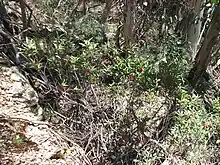
Grevillea victoriae occurs in rocky, mountainous areas of south-eastern Australia in forest, woodland and heath. Associated tree species include Eucalyptus pauciflora and Eucalyptus delegatensis.[28] G. victoriae subsp. victoriae is found on some of Victoria's highest mountains including Mount Bogong, Mount Buffalo, Mount Buller, Mount Hotham, Mount Howitt, Mount St Bernard and Mount Torbreck.[26][29] G. victoriae subsp. nivalis occurs in sub-alpine areas around Mount Kosciuszko and nearby ranges from Mount Gibbo and Mount Sassafras in the Victorian Alps northwards to Talbingo in New South Wales. In rare cases it may be seen above the treeline.[26][30] G. victoriae subsp. brindabella occurs in the Brindabella Range on the border of New South Wales and the Australian Capital Territory.
Ecology
Eastern spinebills and yellow-faced honeyeaters are known to feed on the nectar of Grevillea victoriae sensu lato.[31] In Kosciuszko National Park, it has been noted that many bird species leave the area when Grevillea victoriae finishes flowering in January [32]
Taxa within the Grevillea victoriae complex are believed to be fire intolerant, regenerating from seed only.[21]
Conservation status
Subspecies victoriae and nivalis are listed as "endangered" under the Victorian Government Flora and Fauna Guarantee Act 1988.[16][20]
Use in horticulture
Grevillea victoriae has a reputation for being hardy and reliable in cultivation, and has been successfully grown in all states of Australia, as well as New Zealand, the United States and Great Britain.[33][34] Plants require a well-drained position with full-exposure to sun or partial shade and will benefit from pruning to maintain a more compact shape. Originating from mountainous regions, the species has a high tolerance to frost and snow. It is useful as a screening plant and to attract birds to the garden.[35] In certain parts of North America, hummingbirds feed on the flowers of cultivated plants in the winter.[36]
Plants are easily propagated by seed or cuttings and have been successfully grafted on to Grevillea robusta rootstocks.[34]
Cultivars
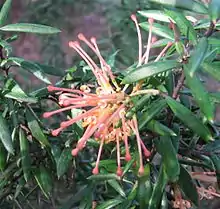
A number of hybrid cultivars involving Grevillea victoriae sensu lato have been developed including the following:
- 'Audrey' - G. juniperina x G. victoriae
- 'Bairnsdale' - selected seedling of G. 'Poorinda Constance'[37]
- 'Canterbury Gold' - G. juniperina (prostrate yellow form) x G. victoriae var.leptoneura[38]
- 'Glen Pearl' - G. victoriae x G. juniperina
- 'Lady O' - G. victoriae hybrid x G. rhyolitica[39]
- 'Orange Box' - G. polychroma x G. juniperina subsp. juniperina [40]
- 'Poorinda Constance' - New South Wales form of G. juniperina x red flower form of G. victoriae[41]
- 'Poorinda Golden Lyre' - G. alpina x G. victoriae[42]
- 'Poorinda Leane' - G. juniperina x G. victoriae[43]
- 'Poorinda Pink Coral' - north-east Victorian form of G. juniperina x G. victoriae[44]
- 'Poorinda Queen' - G. juniperina x yellow flower form of Grevillea victoriae[45]
References
- "Grevillea victoriae". Australian Plant Census. Retrieved 14 April 2023.
- Mkinson, Robert O. "Grevillea victoriae". Royal Botanic Garden Sydney. Retrieved 14 April 2023.
- "Grevillea victoriae". Australian Biological Resources Study, Department of Agriculture, Water and the Environment: Canberra. Retrieved 14 April 2023.
- Stajsic, Val. "Grevillea victoriae". Royal Botanic Gardens, Victoria. Retrieved 14 April 2023.
- Wrigley, John W.; Fagg, Murray A. (1991). Banksias, waratahs & grevilleas : and all other plants in the Australian Proteaceae family. North Ryde, NSW, Australia: Angus & Robertson. pp. 347–348. ISBN 0207172773.
- "Grevillea victoriae". APNI. Retrieved 14 April 2023.
- von Mueller, Ferdinand (1855). Definitions of rare or hitherto undescribed Australian plants. Melbourne: Goodhugh & Trembath. pp. 50–51. Retrieved 15 April 2023.
- Catrice, Daniel. "The Garden of the gods - a brief history of Buffalo National Park" (PDF). Parks Victoria. Archived from the original (PDF) on 2011-02-27. Retrieved 2010-12-02.
- Mueller, Ferdinand (1855). "Descriptive Characters of New Alpine Plants, from Continental Australia". Transactions of the Philosophical Society of Victoria. J.J. Bundell & Co. 1: 96–111.
- "Grevillea victoriae subsp. brindabella". Australian Plant Census. Retrieved 15 April 2023.
- "Grevillea victoriae subsp. brindabella". Plants of the World Online. Retrieved 15 April 2023.
- Stajsic, Val (2010). "Grevillea victoriae subsp. brindabella (Proteaceae), a new subspecies from the Southern Tablelands of New South Wales". Muelleria. 28 (1): 18–28. Retrieved 15 April 2023.
- "Grevillea victoriae subsp. nivalis". Australian Plant Census. Retrieved 15 April 2023.
- "Grevillea victoriae subsp. nivalis". Plants of the World Online. Retrieved 15 April 2023.
- "Grevillea victoriae subsp. nivalis". Australian Biological Resources Study, Department of Agriculture, Water and the Environment: Canberra. Retrieved 15 April 2023.
- Stajsic, Val. "Grevillea victoriae subsp. nivalis". Royal Botanic Gardens, Victoria. Retrieved 14 April 2023.
- "Grevillea victoriae subsp. victoriae". Australian Plant Census. Retrieved 15 April 2023.
- "Grevillea victoriae subsp. victoriae". Plants of the World Online. Retrieved 15 April 2023.
- "Grevillea victoriae subsp. victoriae". Australian Biological Resources Study, Department of Agriculture, Water and the Environment: Canberra. Retrieved 15 April 2023.
- Stajsic, Val. "Grevillea victoriae subsp. victoriae". Royal Botanic Gardens, Victoria. Retrieved 14 April 2023.
- Makinson, R.O. (March 2002). "New segregate species and subspecies from the Grevillea victoriae (Proteaceae: Grevilleoideae) aggregate from south-east New South Wales". Telopea. 7 (2): 129–138. doi:10.7751/telopea19971003.
- "Victoriae Subgroup (Grevillea)". Flora of Australia Online. Department of the Environment and Heritage, Australian Government.
- "Proteaceae" (PDF). Council of Heads of Australasian Herbaria (CHAH). Retrieved 2010-12-07.
- Stajsic, V.; Molyneux, W.M. (2005). "Descriptions of nine previously segregated, and three new taxa". Muelleria. 7 (22): 38–40.
- Molyneux, William M.; Forrester, Susan G. (2015). "A new species Grevillea burrowa (Proteaceae) from the Burrowa-Pine Mountain National Park, North Eastern Victoria" (PDF). Muelleria. 34: 47–54. doi:10.5962/p.292265. S2CID 195293878.
- Olde, Peter (June 2007). "The Grevillea victoriae complex - new species in the Flora" (PDF). Grevillea Study Group Newsletter. Grevillea Study Group, Association of Societies for Growing Australian Plants (77): 10. ISSN 0725-8755.
- "Grevillea victoriae . subsp. nivalis Stajsic & Molyneux,". Flora of Australia Online. Department of the Environment and Heritage, Australian Government.
- Wild Plants of Victoria (database). Viridans Biological Databases & Department of Sustainability and Environment. 2009.
- "Grevillea victoriae F.Muell. subsp. victoriae". Flora of Australia Online. Department of the Environment and Heritage, Australian Government.
- Costin, A.B.; Gray, M. & Totterall, C.D. (2000). Kosciusko alpine flora (2nd ed.). CSIRO. ISBN 0-643-06522-9.
- Lepsci, B.J. (1993). "Food of Some Birds in Eastern New South Wales:Additions to Barker & Vestjens" (PDF). Emu. 93 (3): 195–99. doi:10.1071/mu9930195.
- Davey, Chris (March 2002). "The Kosciuszko blitz: A survey of birds from Thredbo to the summit" (PDF). Canberra Bird Notes. 27 (1). ISSN 0314-8211.
- Matthews, Lewis J. (2002). The protea book: a guide to cultivated Proteaceae. Portland, Oregon: Timber Press. p. 78. ISBN 0-88192-553-5. Retrieved 2010-12-06.
- Olde, P.; Marriott, N. (1980). The Grevillea Book. Australia: Kangaroo Press. ISBN 0-86417-616-3.
- Greig, D. (1987). The Australian Gardener's Wildflower Catalogue. Australia: Angus & Robertson. ISBN 0-207-15460-0.
- "Grevillea victoriae". UBC Botanical Garden and Centre for Plant Research. Archived from the original on 2010-06-12. Retrieved 2010-12-01.
- "Grevillea 'Bairnsdale'". Descriptions of Registered Cultivars. Australian Cultivar Registration Authority. Retrieved 2010-12-07.
- "Grevillea 'Canterbury Gold'". Descriptions of Registered Cultivars. Australian Cultivar Registration Authority. Retrieved 2010-12-03.
- "Grevillea 'Lady O'". Bywong Nursery. Retrieved 2010-12-03.
- "Fact sheet:Genus species : Grevillea polychroma x juniperina ssp. juniperina". Austraflora. Archived from the original on 2011-07-07. Retrieved 2010-12-03.
- "Grevillea 'Poorinda Constance'". Descriptions of Registered Cultivars. Australian Cultivar Registration Authority. Retrieved 2010-12-03.
- "Grevillea 'Golden Lyre'". Descriptions of Registered Cultivars. Australian Cultivar Registration Authority. Retrieved 2010-12-03.
- "Grevillea 'Poorinda Leane'". Descriptions of Registered Cultivars. Australian Cultivar Registration Authority. Retrieved 2010-12-03.
- "Grevillea 'Poorinda Pink Coral'". Descriptions of Registered Cultivars. Australian Cultivar Registration Authority. Retrieved 2010-12-03.
- "Grevillea 'Poorinda Queen'". Descriptions of Registered Cultivars. Australian Cultivar Registration Authority. Retrieved 2010-12-03.